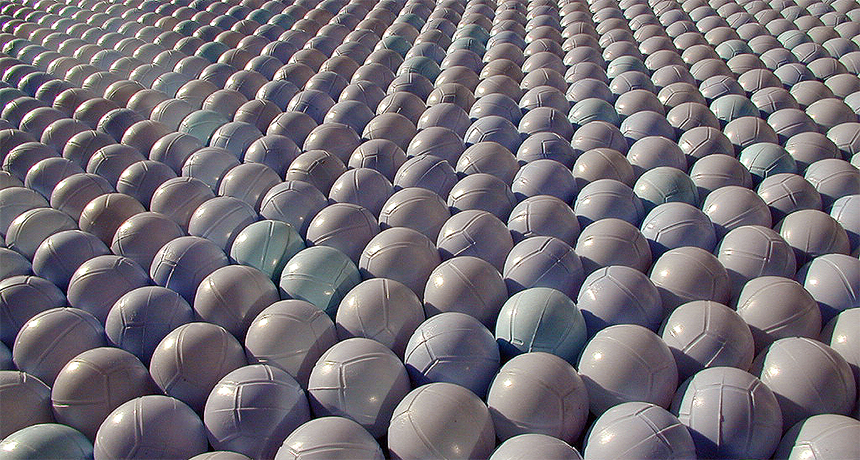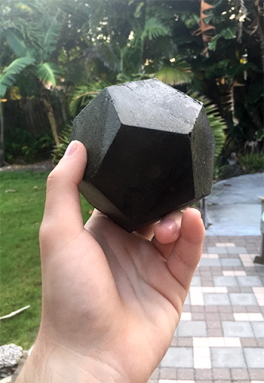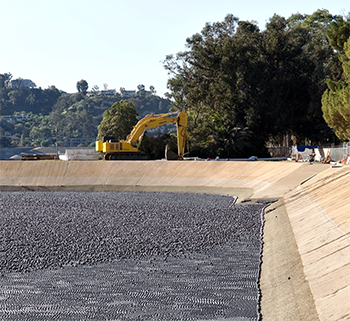Maybe ‘shade balls’ should not be balls
Teen’s tests suggest a 12-sided shape would cut evaporation from reservoirs better, fight mosquitoes too

The shade balls seen floating on a pool, here, can trim evaporation from surface waters. But such “balls” would work even better if they had 12 flat sides, a new study finds.
Harald Bischoff/Wikimedia Commons (CC BY-SA 3.0)
Share this:
- Share via email (Opens in new window) Email
- Click to share on Facebook (Opens in new window) Facebook
- Click to share on X (Opens in new window) X
- Click to share on Pinterest (Opens in new window) Pinterest
- Click to share on Reddit (Opens in new window) Reddit
- Share to Google Classroom (Opens in new window) Google Classroom
- Click to print (Opens in new window) Print
By Sid Perkins
LOS ANGELES, Calif. — Engineers sometimes dump large numbers of hollow plastic softball-sized spheres into water reservoirs. These so-called shade balls spread out to cover the water’s surface. They are meant to help cut evaporation in dry areas, among other things. But one teen’s research now suggests they’d trim water loss even better if they were 12-sided, not round.

Shade balls cut down on evaporation several ways, explains Kenneth West. He’s a Florida 10th-grader at Melbourne High School. As their name suggests, the balls shade the underlying water, keeping it cool. And cooler water evaporates more slowly than warm water. Second, a layer of balls reduces the area of water exposed to the air. But a round shape doesn’t fully cover the water’s surface, Kenneth notes. Even when packed at their tightest, up to 10 percent of the water’s surface can be exposed to the air. So the 16-year-old decided to see whether another shape would cut evaporation even better. His shape of choice: the 12-sided dodecahedron (Do-DEK-ah-HE-drun). It’s the same shape as a 12-sided die used in some games.
Kenneth showcased his research last week, here, at the Intel International Science and Engineering Fair. ISEF was created by Society for Science & the Public and is sponsored by Intel. The competition lets students from around the world show off their winning science fair projects. (The Society also publishes Science News for Students.) This year, nearly 1,800 high school students from more than 75 countries competed for big prizes and the ability to display their research. Kenneth landed a $500 prize in the division of Earth and Environmental Science for his research.
What his data showed
For his experiments, Kenneth placed 12 bins in his yard and filled them with water. He covered the water in some bins with a layer of regular shade balls. In other bins, he covered the surface of the water with floating dodecahedrons. In yet others, he had only water. After 10 days, he measured water levels in each bin. That let him calculate the amount of evaporation that had occurred.
Open bins lost more than half (53 percent) of their water, on average. Bins covered with shade balls lost only a little more than a third (36 percent). But in the bins covered with dodecahedrons, less than 1 percent of the water had evaporated. That’s because the dodecahedrons almost completely covered the surface. If you take a dodecahedron and slice it in half, the cross-section looks like a hexagon, Kenneth notes. And hexagons, if packed perfectly, will completely cover a 2-dimensional surface.

Shade balls typically cut down on algae growth, says Kenneth. And in his tests, the 12-sided “balls” are better here, too. After 10 days, polluting algae that had taken hold in the no-ball bin blocked about 17 percent of the light shining through it. Less algae was in the water covered with regular shade balls. There, algae blocked only about 11 percent of the light shining through the water. And where the dodecahedrons had been used, the water was the clearest of all. Algae blocked less than 4 percent of the light that shone through it, Kenneth reports.
The 12-sided shade balls had another unexpected benefit: They stifled mosquito reproduction. In both the open bins and those with regular shade balls, adult mosquitos could still get to the water’s surface and lay eggs. But in the bins covered with floating 12-sided “balls,” he found no mosquito larvae. That means that changing the shape of shade balls might even cut down on the spread of mosquito-borne diseases, such as malaria and Zika. And in some parts of the country, that could be a big deal, the teen notes.






